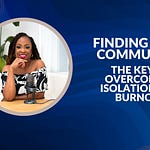When most people think about workplace safety, they imagine hard hats, ergonomic chairs, or maybe active shooter drills. What rarely comes up—but absolutely should—is how people feel at work. And that’s where psychosocial hazards come in.
These aren’t just buzzwords or boxes to check. Psychosocial hazards are the silent threats that show up in how power is distributed, how people are treated, and what’s tolerated in the day-to-day culture of an organization. And yet, too often, they go unacknowledged—until someone breaks down, quits, or worse.
Dr. I David Daniels joined me on DEI After 5 to dig into this topic, and what he shared should have every workplace paying attention.
What Are Psychosocial Hazards, Really?
Psychosocial hazards are the workplace conditions that can mess with your mental and emotional well-being. Things like:
Bullying or harassment (yep, still happening in 2025)
Excessive workload and unrealistic expectations
Micromanagement and lack of control over your own work
Isolation, exclusion, or lack of social support
Microaggressions (subtle, but cumulative and harmful)
Discrimination—overt or covert
These aren't just "bad vibes." These are real risk factors that impact how people think, engage, and show up at work. And if we’re being honest, they’re often written off as personal problems or interpersonal drama instead of being seen as organizational liabilities.
Microaggressions: The “Small” Thing That Adds Up Fast
Let’s talk about microaggressions—those quick jabs people might not even realize they’re throwing. A joke about someone’s name. A comment about someone’s tone. A backhanded compliment about someone’s hair or clothes. These small moments are heavy for the person on the receiving end, especially when they pile up over time.
If people are spending energy trying to decode whether they’re safe in a meeting or if it’s “worth it” to speak up, that’s not a thriving culture. That’s a hazard.
Toxic Workplaces Don’t Just Happen. They’re Built.
A toxic work environment is often the result of unchecked psychosocial hazards. Maybe it's a culture of fear. Maybe it’s leadership looking the other way when inappropriate behavior happens. Maybe it's the team dynamic that subtly punishes people for being “too different” or “too direct.”
Whatever the case, the result is the same: employees disengage, mental health declines, and performance suffers. Burnout isn’t always about doing too much—it’s often about being in an environment that takes too much out of you, with too little support in return.
So, What Can Organizations Actually Do?
Addressing psychosocial hazards takes more than a wellness webinar or a ping pong table in the break room. Here’s where to start:
Take a real look at the culture. What’s being allowed? What’s being ignored?
Train leaders to recognize and respond to harmful behavior. Silence is complicity.
Reinforce policies with action—not just paperwork. If people don’t trust the system, it doesn’t work.
Create real feedback channels. And act on what you hear.
Prioritize psychological safety. Not just for show—but because it matters.
Leadership Sets the Tone
This isn’t just an HR issue—it’s a leadership responsibility. Leaders shape culture, whether intentionally or not. If they’re not actively creating safety, then they might be passively reinforcing harm. Listening, transparency, and accountability are all leadership behaviors that reduce psychosocial hazards. It's time we stop thinking of those things as "soft skills" and start calling them what they are: critical safety tools.
If your team is struggling, your retention is dipping, or people are showing signs of burnout—don’t just look at the workload. Look at the environment. Psychosocial hazards may be the root cause.
If you're ready to dig into what's really going on in your workplace and want support assessing and addressing psychosocial hazards, schedule a call with our team. We’ll help you build a culture that’s not just productive—but safe, sustainable, and truly inclusive.













Share this post